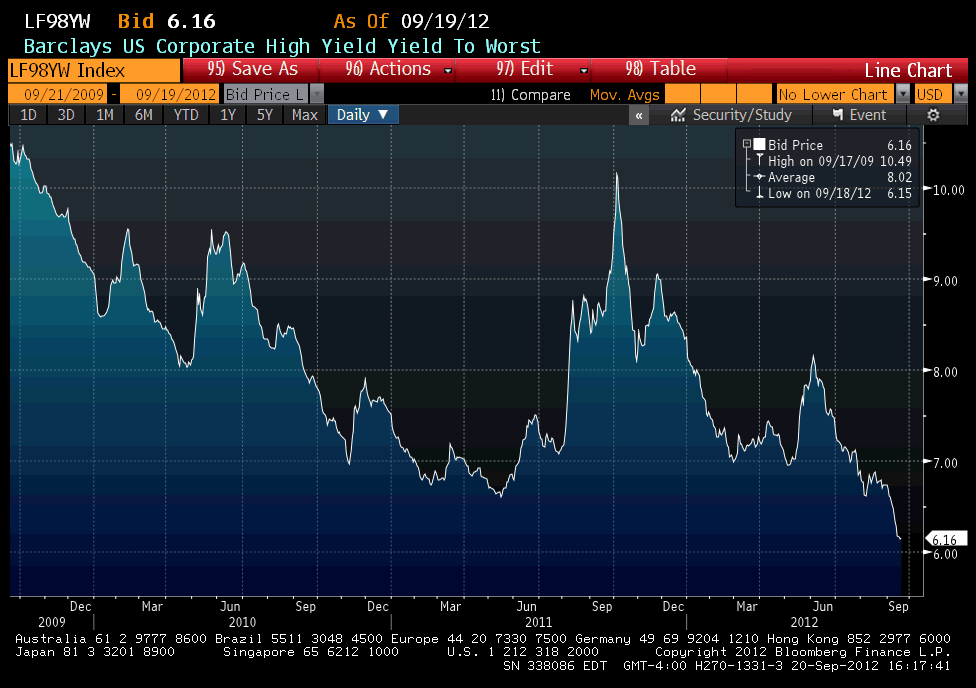There are many critics blasting the recent Fed’s announcement of QE3, suggesting it’s ineffectiveness since Treasury rates are higher or that mortgage rates are stagnant and not enough to make a material impact on the economy. Furthermore, higher inflation is apparent in the data with the long end of the yield curve rising resulting in a steepening of the yield curve.
While it is true that the Federal Reserve has targeted homeowners before in the past, the Fed’s latest action in QE3 is not designed to stimulate the economy only via the housing market but also to improve financial conditions. Better financial conditions promote better access to capital across many forms which in turn should improve demand and economic growth. It is through this channel that the Federal Reserve plans to fight the stagnant labor markets.
After Fed Chairman, Ben Bernanke hinted in his speech at the central bankers symposium at Jackson Hole and after its last meeting, the Federal Reserve committed to expanding its balance sheet. The U.S. central bank plans to purchase U.S. Agency Mortgage Backed Securities (MBS) to the tune of $40 billion per month until the labor market improves significantly. The expansion will remain open ended which may morph into the addition of U.S. Treasuries.
Obviously, this has had a major effect on the U.S. Agency MBS market with yields collapsing to near U.S. Treasuries.
Since the hint of central bank intervention on August 31, 2012, the yield differential or spread over U.S. Treasuries which represents the incremental return associated with the risk unique to MBS, has collapsed to near zero. Since the end of August, the nominal spread of Agency MBS was at 72 basis points. Today, it is at all-time lows and is currently trading at just 15 basis points.
Essentially, an investor will earn the same using MBS as U.S. Treasuries while taking on significantly more risk in the form of prepayments and negative convexity. Suffice to say, the spread is extremely rich.
Of course, this should not be a surprise to Bernanke and company since that is their intent. On the surface the intent of QE3 is to help promote the housing market which is all well and good. However, the real purpose is much greater than that.
The Federal Reserve President noted in his Jackson Hole speech that the purchases and subsequent richening of MBS would trickle down to other asset classes. Bernanke said the following:
Thus, Federal Reserve purchases of mortgage-backed securities (MBS), for example, should raise the prices and lower the yields of those securities; moreover, as investors rebalance their portfolios by replacing the MBS sold to the Federal Reserve with other assets, the prices of the assets they buy should rise and their yields decline as well. Declining yields and rising asset prices ease overall financial conditions and stimulate economic activity through channels similar to those for conventional monetary policy.
Given the supply trends of the various fixed income products, the Fed’s purchases of MBS will undoubtedly overwhelm the amount of new issuance for most taxable bonds. JP Morgan Credit Strategist, Eric Beinstein suggested that if you use history as a guide for supply across most non-government-related fixed income sectors and subtract out the expected Fed purchases of MBS, the net supply could be zero or perhaps even negative. In their latest Credit Market Outlook & Strategy, they provided the following:
Net issuance across credit and mortgage products this year (issuance less maturities for US HG, HY, EM sovereign and EM corporate credit, MBS, CMBS, ABS and CLOs) is likely to be about $300bn. With the Fed set to buy about $140bn of mortgages this year and up to $480bn next year, net supply of spread product available to the market going forward (i.e. ex the Fed) will likely be near zero or negative. We don’t have issuance forecasts across spread products for 2013 yet so we can’t be sure, but net issuance has been below $480bn for each of the last 4 years so its likely that net issuance will be negative for this group of products if the Fed does continue the buying at $40bn/month for all of 2013.
Obviously, this reality is a positive for bond investors (and equities) as this will lead to a richening of spreads and provide excess returns over Treasuries. This is already occurring with the massive decline in spreads as seen in credit products such as High Yield.
Since the Jackson Hole speech, the spread on the Barclays’ High Yield Index has collapsed. The spread over comparable U.S. Treasuries for High Yield has dropped from 575 basis points to 516. Equally important, the yield on the index has dropped to all time historical lows with the index falling to 6.16%. 
This drop in corporate yields lowers borrowing costs even more for businesses which should improve profit margins. Lower rates, coupled with rising equity prices will hopefully encourage corporate borrowing and bond issuance that may lead to expansion, promote business investment, and increases in hiring. In addition, as we have seen in the past, rising equity prices and gains on the housing front can rejuvenate consumer spending via the wealth effect. In other words, as people can see their assets improve in value, the more secure they become in their financial well-being. This confidence and feeling of being richer, whether real or not, can translate into spending.
It is through these measures, the Federal Reserve hopes to combat the labor markets that have remained stubbornly stagnant throughout this recovery. If borrowing rates stay low and equities rally on, it means that financial conditions are better which will hopefully translate to labor growth. The fact that Treasury rates are not lower is completely irrelevant.
- English (UK)
- English (India)
- English (Canada)
- English (Australia)
- English (South Africa)
- English (Philippines)
- English (Nigeria)
- Deutsch
- Español (España)
- Español (México)
- Français
- Italiano
- Nederlands
- Português (Portugal)
- Polski
- Português (Brasil)
- Русский
- Türkçe
- العربية
- Ελληνικά
- Svenska
- Suomi
- עברית
- 日本語
- 한국어
- 简体中文
- 繁體中文
- Bahasa Indonesia
- Bahasa Melayu
- ไทย
- Tiếng Việt
- हिंदी
Why The Federal Reserve Doesn't Care If Treasury Yields Are Higher
Published 09/24/2012, 12:40 AM
Updated 07/09/2023, 06:31 AM
Why The Federal Reserve Doesn't Care If Treasury Yields Are Higher
Latest comments
Install Our App
Risk Disclosure: Trading in financial instruments and/or cryptocurrencies involves high risks including the risk of losing some, or all, of your investment amount, and may not be suitable for all investors. Prices of cryptocurrencies are extremely volatile and may be affected by external factors such as financial, regulatory or political events. Trading on margin increases the financial risks.
Before deciding to trade in financial instrument or cryptocurrencies you should be fully informed of the risks and costs associated with trading the financial markets, carefully consider your investment objectives, level of experience, and risk appetite, and seek professional advice where needed.
Fusion Media would like to remind you that the data contained in this website is not necessarily real-time nor accurate. The data and prices on the website are not necessarily provided by any market or exchange, but may be provided by market makers, and so prices may not be accurate and may differ from the actual price at any given market, meaning prices are indicative and not appropriate for trading purposes. Fusion Media and any provider of the data contained in this website will not accept liability for any loss or damage as a result of your trading, or your reliance on the information contained within this website.
It is prohibited to use, store, reproduce, display, modify, transmit or distribute the data contained in this website without the explicit prior written permission of Fusion Media and/or the data provider. All intellectual property rights are reserved by the providers and/or the exchange providing the data contained in this website.
Fusion Media may be compensated by the advertisers that appear on the website, based on your interaction with the advertisements or advertisers.
Before deciding to trade in financial instrument or cryptocurrencies you should be fully informed of the risks and costs associated with trading the financial markets, carefully consider your investment objectives, level of experience, and risk appetite, and seek professional advice where needed.
Fusion Media would like to remind you that the data contained in this website is not necessarily real-time nor accurate. The data and prices on the website are not necessarily provided by any market or exchange, but may be provided by market makers, and so prices may not be accurate and may differ from the actual price at any given market, meaning prices are indicative and not appropriate for trading purposes. Fusion Media and any provider of the data contained in this website will not accept liability for any loss or damage as a result of your trading, or your reliance on the information contained within this website.
It is prohibited to use, store, reproduce, display, modify, transmit or distribute the data contained in this website without the explicit prior written permission of Fusion Media and/or the data provider. All intellectual property rights are reserved by the providers and/or the exchange providing the data contained in this website.
Fusion Media may be compensated by the advertisers that appear on the website, based on your interaction with the advertisements or advertisers.
© 2007-2024 - Fusion Media Limited. All Rights Reserved.
